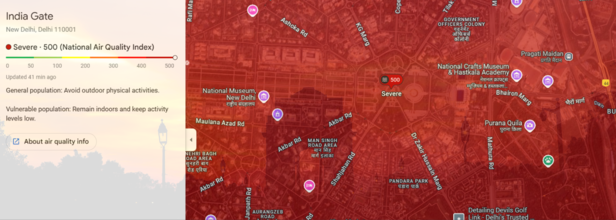- Health Conditions A-Z
- Health & Wellness
- Nutrition
- Fitness
- Health News
- Ayurveda
- Videos
- Medicine A-Z
- Parenting
- Web Stories
Breathing In Delhi Is Like Smoking 30 Cigarettes A Day

Credits: canva
Despite the GRAP-III being enforced in Delhi-NCR, pollution has continued to rise. AQI at several places in Delhi-NCR stands at 500, including New Friends Colony, Anand Vihar, ITO (Bahadur Shah Zafar Marg), Saket, and India Gate.
Amid this, the government has enforced GRAP-IV from Monday to combat air pollution.
What's allowed, what's not?
- Diesel-run medium and heavy goods vehicles running on BS-IV or below are banned, except those carrying essential goods.
- Non-essential light commercial vehicles from outside Delhi are prohibited, unless it runs on cleaner fuel like CNG, BS-VI diesel, or are electric vehicles
- Truck carrying non-essential items are barred from entering Delhi unless they operate on LNG, CNG, or BS-VI diesel.
- For school, students from classes 6 to 9 and 11 will be shifted to online mode. Primary classes have already been following it.
- NCR offices to operate at 50% capacity, with remaining workforce working from home.
Breathing in Delhi is like smoking 30 cigarettes in a day
A report by the University of Chicago revealed that air pollution is reducing the life expectancy of Delhi residents by 7.8 years. As per a US-based NGO report by the Health Effects Institute, there has been 30 to 50% increase in lung cancer rates associated with pollutants. A recent 2024 study also revealed that air pollution is not just linked to lung cancer but it can also cause head and neck cancer.
"Head and neck cancer is a harder link to show, and it has a much lower occurrence than lung cancers, but since they also occur as a result of smoking, similar to lung cancers, we wanted to explore any connections," said John Cramer, the study's lead researcher. "Presumably, the link to head and neck cancer comes from what we breathe to that material affecting the lining in the head and neck. We see a lot of occurrences of where carcinogens touch or pool in the body to where cancers can occur," he explained.
Tata Memorial Hospital published a study in July that revealed most people who had lung cancer in India never smoked.
On average, if you smoke a cigarette, you consume 1-2 milligram of nicotine. With nicotine, you are smoking somewhere between 7,000 to 8,000 different chemicals, which can cause cancer. These chemicals include carbon monoxide, nickel, PAHs, ammonia, nitrogen oxides, carbon dioxide, and many more such chemicals that also constitute air pollution.
Our body has many structures which are capable of repairing themselves, however, the lung is not one of them. When you smoke, it causes damage to alveoli, and small air sacks in our lungs. It becomes more fibrous and makes it harder for people to expand their lungs to fully inhale. Less lung tissue and less expansion means less oxygen is getting to the places where your body needs. Since our lungs have around 500 million air sacs, the damage that is done happens over time. It takes around 15 to 20 years to lose enough of these air sacks to become obvious. However, living in Delhi is like experiencing the same, without having to smoke any cigarettes at all.
This is why experts suggest to always wear an N-95 mask whenever you are out, or avoid going out altogether. If you must, go out in the afternoon, as the pollution is at its lowest during that time, even then, do not forget to wear your mask.
'Pretty Little Baby' Singer Connie Francis Passes Away At 87, What Happened To Her?

Credits: Wikimedia Commons
Legendary pop singer Connie Francis, whose voice defined an era with heartbreak ballads and upbeat rock-n-roll hits, has died at the age of 87. Her publicist and longtime friend, Ron Roberts, confirmed the news on Facebook on Thursday, writing:
“It is with a heavy heart and extreme sadness that I inform you of the passing of my dear friend Connie Francis last night. I know that Connie would approve that her fans are among the first to learn of this sad news.”
Though the cause of her death has not yet been made public, Francis had been hospitalized just two weeks earlier for what she described as “extreme pain” due to a pelvic fracture. The beloved singer had kept fans updated about her health condition through heartfelt posts on social media.
Health Struggles in Her Final Days
On July 2, Francis shared that she had been hospitalized in Florida, undergoing tests to identify the cause of her pain. Her updates were filled with optimism, despite having been moved to the intensive care unit and missing a scheduled appearance on Cousin Brucie’s Independence Day radio show.
By July 3 and 4, Francis posted that she was “feeling much better,” and expressed gratitude for her supporters. However, she remained under medical observation, and in a post the following week, she revealed that doctors were still trying to get to the root of her condition.
This wasn’t her first health battle.
In May, Francis had shared that she had suffered a hip injury that left her temporarily wheelchair-bound. Her openness about her condition made her all the more endearing to longtime fans who had followed her through the highs and lows of both her professional and personal life.
A Trailblazing Career That Crossed Borders and Genres
Born Concetta Rosa Maria Franconero in 1937, Connie Francis rose to fame in the late 1950s with her breakthrough hit “Who’s Sorry Now,” a song that she famously performed on television after nearly being dropped by her label. The track became a massive hit, charting internationally and setting the stage for a string of chart-topping singles.
She followed with hits like “Stupid Cupid,” “Lipstick on Your Collar,” “Don’t Break the Heart That Loves You,” and the carefree anthem “Vacation.” Her clear, emotional voice resonated with millions and helped her bridge musical genres—from rock ’n’ roll and country to standards and international ballads.
Francis sang in more than a dozen languages, including Italian, Yiddish, and Swedish, and found global success at a time when international stardom was rare for American artists. Her versatility and emotional range made her one of the best-selling female pop stars of her generation.
A Social Media Resurgence in Recent Years
In the digital age, Connie Francis found renewed fame among younger audiences thanks to social media platforms like TikTok and Instagram Reels. Her 1965 song “Pretty Little Baby” became a viral favorite, introducing her music to a new generation and reminding the world of her timeless appeal.
Flesh-Eating Bacteria Claims 4 Lives in Florida: What You Should Know

Credits: Canva
Four people in Florida have died from Vibrio vulnificus, a dangerous bacterium often dubbed the "flesh-eating" bacteria, as the state reports a total of 11 infections this summer. The deaths occurred across Hillsborough, Bay, Broward, and St. Johns counties, according to the Florida Department of Health’s latest update released on July 11.
Cases have also been identified in Duval, Escambia, Lee, Manatee, Santa Rosa, and Walton counties. While the numbers might seem small, health officials say the consequences can be devastating if the infection is not caught early.
What Is Vibrio Vulnificus?
Vibrio vulnificus is a naturally occurring bacterium found in warm saltwater or brackish water, which is a mix of salt and freshwater. It thrives particularly well during the hotter months, which is why infections spike from May through October. According to the Centers for Disease Control and Prevention (CDC), the bacteria is halophilic, meaning it needs salt to survive.
While rare, the infection can cause necrotizing fasciitis. It is a condition where flesh-eating bacteria could destroy the tissue under the skin, and can lead to death in just a few days if left untreated.
How People Get Infected?
According to Dr. Norman Beatty, an infectious disease specialist and associate professor at the University of Florida, as reported by WUSF, West Central Florida's NPR station broadcasting news, there are two main ways people typically contract Vibrio vulnificus.
“We can consume it through contaminated shellfish, specifically oysters,” Beatty said. If ingested, the bacteria can cause symptoms like nausea, vomiting, diarrhea, and abdominal cramps.
Also Read: 'Pretty Little Baby' Singer Connie Francis Passes Away At 87, What Happened To Her?
But the more dangerous and more common route, he explains, is through open wounds. “If someone with a cut or scrape enters brackish or saltwater contaminated with Vibrio vulnificus, the bacteria can enter the body through the skin and cause serious infection,” he warned.
Symptoms to Watch For
Symptoms often appear quickly; sometimes within hours of exposure. Early signs include redness, pain, and swelling around the wound. As the infection progresses, it can cause skin ulcers, blisters, and even tissue death. Systemic symptoms like fever, chills, and low blood pressure may also follow.
“A delay in treatment can lead to serious complications, including amputations or even death,” Dr. Beatty cautioned.
Who’s Most at Risk?
People with weakened immune systems, liver disease, or chronic health conditions are at greater risk of developing severe infections. But Dr. Beatty emphasized that even healthy individuals aren’t immune.
“I’ve seen otherwise healthy people who got a small cut while fishing or kayaking and ended up battling this infection,” he said.
How to Stay Safe?
With summer in full swing and more people spending time in and around water, doctors urge caution. If you have an open wound, avoid wading or swimming in warm seawater or brackish water. If exposure happens accidentally, clean the wound immediately with soap and bottled water. Covering healing wounds with waterproof bandages can also reduce the risk of infection.
If symptoms develop after being in such water or consuming raw seafood, particularly oysters, seek medical attention immediately and inform the doctor of your recent exposure.
A Persistent Health Threat
WUSF reports that in 2024 alone, Florida reported 82 Vibrio vulnificus cases and 19 deaths. Some of those were tied to flooding from Hurricane Helene, which caused contaminated water to spread inland. In past years, spikes in infections have been linked to major storms and hurricanes, including Hurricane Ian in 2022.
The CDC estimates around 80,000 Vibrio-related illnesses occur in the U.S. each year, with about 100 deaths, many of them preventable with timely care.
As Dr. Beatty puts it, “This is not a bacteria to take lightly. With increased awareness and a bit of caution, we can lower the risk and save lives.”
US President Trump Is Diagnosed With A Chronic Vein Condition, Venous Insufficiency, Confirms White House

Makeup covering the Bruise, Credits: White House, Sate News and AP; Donald Trump (PTI)
Donald Trump, announced the White House, is suffering from a chronic vein condition, known as venous insufficiency. The news was announced on Thursday, after days of speculation regarding photographs that showed bruising on the US president's hand.
Trump also experienced swelling in his legs and underwent a "comprehensive exam" while he took an aspirin. As per the White House Press Secretary Karoline Leavitt said that Trump's bruised hand was consistent with "tissue damage from frequent handshaking", and taking aspirin was "part of a standard cardio-vascular prevention regimen".
For Trump and his supporters this news comes as a blow, not just because of his health concerns, but also because he, 79, has often boasted about his good health, so far to say, "the healthiest president that's ever lived".
Also Read: 'Pretty Little Baby' Singer Connie Francis Passes Away At 87, What Happened To Her?
What Is Chronic Venous Insufficiency?
As per John Hopkins Medicine, chronic venous insufficiency occurs when your leg veins don’t allow blood to flow back up to your heart. Normally, the valves in your veins make sure that blood flows toward your heart. But when these valves don’t work well, blood can also flow backwards. This can cause blood to collect (pool) in your legs.
Symptoms, especially if not treated well, could lead to:
- Pain
- Swelling
- Cramps
- Skin Changes
- Varicose Veins
- Legs Ulcers
What Causes This Condition?
This condition could happen if you are overweight, pregnant, or have a family history of the problem. It can also happen if you had damage to your leg due to an injury, surgery, or any previous blood clot.
Other causes are:
High blood pressure in the leg veins over time, due to sitting or standing for long periods
- Lack of exercise
- Smoking
- A blood clot in a deep vein, often in the calf or thigh (deep vein thrombosis)
- Swelling and inflammation of a vein close to the skin, often in the legs (phlebitis)
John Hopkins Medicine notes the following as symptoms of the condition:
- Swelling in your legs or ankles
- Tight feeling in your calves or itchy, painful legs
- Pain when walking that stops when you rest
- Brown-colored skin, often near the ankles
- Varicose veins
- Leg ulcers that are sometimes hard to treat
- Having an uncomfortable feeling in your legs and an urge to move your legs (restless legs syndrome)
- Painful leg cramps or muscle spasms (charley horse)
What Do The Officials Say?
As per Dr Meryl Logan, assistant professor of vascular surgery at the University of Texas at Austin, veins and valves in this condition "propel the blood up and out of the leg" and back toward the heart, as is also reported by the BBC.
"So what chronic venous insufficiency is, is when those veins and valves don't work and blood goes backwards down the legs," she said.
White House physician Sean Barbabella has confirmed in a statement to reporters that Donald Trump’s condition is “benign and common,” particularly among people over the age of 70.
Further tests showed no evidence of heart failure, kidney issues, or any other systemic illness, Barbabella noted, echoing details shared earlier by spokesperson Steven Cheung and Trump advisor Brian Leavitt.
The doctor added that, overall, Trump is in “excellent health.”
Speculation began after photographers spotted what looked like swelling in Trump’s legs during the FIFA Club World Cup final in New Jersey on July 13. A few days later, photos from his meeting with Bahraini Prime Minister Salman bin Hamad bin Isa Al Khalifa at the White House showed noticeable bruising on his hands.
© 2024 Bennett, Coleman & Company Limited

